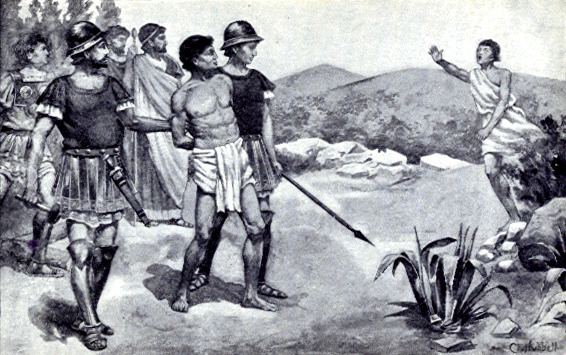 | ||
In Greek historic writings, Damon and Pythias (or Phintias; Greek: Δάμων (gen.: Δάμωνος), Πυθίας, Φιντίας) is a legend surrounding the Pythagorean ideal of friendship. Pythias is accused and charged of creating a plot against the tyrannical Dionysius I of Syracuse. Pythias makes a request of Dionysius that he be allowed to settle his affairs on the condition that he leaves his friend, Damon, as a hostage, so if Pythias does not return, Damon would be executed. Eventually, Pythias returns to face execution to the amazement of Dionysius, who because of the sincere trust and love of their friendship, then lets both Damon and Pythias go free.
Contents
Greek legend
As told by Aristoxenus, and after him Cicero (De Offic. 3.45), Diodorus Siculus (10.4), and others, Pythias and his friend Damon, both followers of the philosopher Pythagoras, traveled to Syracuse during the reign of the tyrannical Dionysius I (r. 405–367 BC). Pythias was accused of plotting against the tyrant and was sentenced to death.
Accepting his sentence, Pythias asked to be allowed to return home one last time, to settle his affairs and bid his family farewell. Not wanting to be taken for a fool, the king refused, believing that once released, Pythias would flee and never return.
Damon offered to take his spot while he was gone. The king agreed, on the condition that, should Pythias not return when promised, Damon would be put to death in his place. Damon agreed, and Pythias was released.
Dionysius was convinced that Pythias would never return, and as the day Pythias promised to return came and went, Dionysius prepared to execute Damon. Just as the executioner was about to kill Damon, though, Pythias returned.
Apologizing to his friend for his delay, Pythias told of how pirates had captured his ship on the passage back to Syracuse and thrown him overboard. Dionysius listened to Pythias as he described how he swam to shore and made his way back to Syracuse as quickly as possible, arriving just in time to save his friend.
Dionysius was so pleased and astonished with their friendship that he pardoned them both. It was also said that Dionysius then sought to become their third friend, but was denied.
Another version says that it was a test planned out by Dionysius and his courtiers. The Pythagoreans were known for their claimed moral strength and superiority. Courtiers of Syracuse believed that they were fakes, while others disagreed. The plan was devised to test the Pythagoreans' moral strength in a time of crisis.
Works based on the legend
Idiomatic use
"Damon and Pythias" came to be an idiomatic expression for "true friendship". Thus, Denis Diderot's short story, "The Two Friends from Bourbonne" (1770), begins "There used to be two men here who might be called the Damon and Pythias of Bourbonne." The canines Bummer and Lazarus were eulogized as "the Damon and Pythias of San Francisco" upon Bummer's death in 1865.
In Robert Louis Stevenson's novella "The Strange Case of Dr. Jekyll and Mr. Hyde", Henry Jekyll's two oldest friends, Dr. Lanyon and Mr. Utterson (a lawyer), have the following exchange while discussing Dr. Jekyll's apparent self-imposed isolation:
...said Utterson. “I thought you had a common bond of interest.”
“We had,” was the reply. “But it is more than ten years since Henry Jekyll became too fanciful for me. He began to go wrong, wrong in the mind… Such unscientific balderdash,” said the doctor, flushing suddenly purple, “would have estranged Damon and Pythias.”
The use of the Damon-and-Pythias idiom would seem to indicate that, whether the difference was on a point of science or something else, it was not "only" some trivial difference.
The 1889 novel A Marriage Below Zero by Alfred J. Cohen (pen name: Alan Dale) has a young gay couple continually referring to themselves as Damon and Pythias. Soon the upscale social world that they try pass in begins to refer to them with the same term, but as derogatory codeword for 'gay couple.'
Shakespeare's Hamlet addresses his close friend Horatio as "O Damon dear".
Two clerks arrested for drunk and disorderly conduct in Charles Dickens's story "Making a Night of It" (in Sketches by Boz) allude to Damon and Pythias.
In A Bell for Adano, Captain Purvis's and Mayor Joppolo's friendship is compared to the friendship of Damon and Pythias because they dated sisters.
In 1895, Jack London used Damon and Pythias as the nicknames of the two main characters in "Who Believes in Ghosts!" .
In a 1997 episode of the TV series Highlander entitled "A Modern Prometheus", a character portraying Lord Byron references the dynamic duo of Damon and Pythias before he jumps with another man to their "death".
In the 1940 movie The Philadelphia Story, Tracy Lord (Katharine Hepburn) remarks ironically that C. K. Dexter Haven (Cary Grant) and George Kittredge (John Howard) are just like Damon and Pythias.
In the 1950 Bowery Boys movie Blonde Dynamite, the boys establish a male escort service out of their foil Louie's ice cream parlor while they have conveniently sent him to Coney Island on vacation; Slip Mahoney (Leo Gorcey) tells the other boys to "Let Damon and Pythias fight it out!" referring to Sach and Whitey (Huntz Hall and Billy Benedict) as to which of the two will be included in a group date with a bevy of femmes fatale.
In the 1971 PG Wodehouse novel Much Obliged, Jeeves, Bertie Wooster tells his Aunt Dahlia that at Oxford, his friendship with Ginger Winship was comparable to that of Damon and Pythias.
In Episode 8, season 1 of Peter Gunn, a character describes his friendship for the murder victim by saying that people referred to them as "Damon and what's-his-name."
